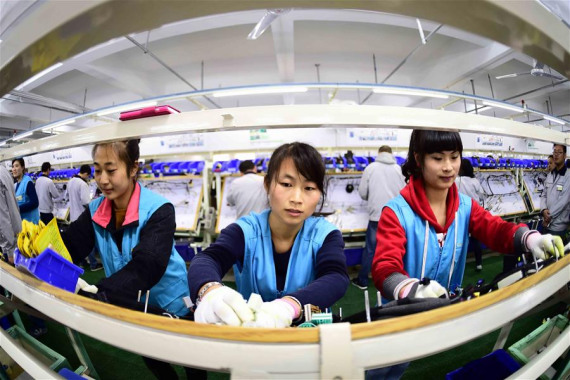
People work at a workshop in Rushan in east China's Shandong Province, Nov. 12, 2015. The statistics authority on Thursday verified the country's 2014 growth rate as 7.3 percent, unchanged from the preliminary verification figure. (Photo: Xinhua/Guo Xulei)
China's stock market fluctuation and the yuan's depreciation in the first week of 2016 do little to disguise what could be a very difficult year ahead.
China is braced for unavoidable pains which it expects to precede future gains.
On Thursday, the just-introduced circuit breaker into the Chinese stock market was triggered for the second day in four trading days.
Within half an hour after opening, shares were down by 7 percent, the biggest move allowed before trading ceases for the remaining of a trading day.
The foreign exchange market is also reeling. The central parity rate of the yuan lost 332 basis points to 6.5646 against the U.S. dollar, its lowest level in nearly five years.
These developments have caused global concerns, even though the market consensus holds that such volatility has a limited impact on the real economy.
Confidence is unsteady, partly due to the slowdown of China's economy. Performance has crumbled to levels not seen for over six years.
For the 2016-2020 period, President Xi Jinping has stated that an annual growth of 6.5 percent would be required for China to complete the building of "a moderately prosperous society" by 2020.
The rate may seem disappointing if compared with the country's often double-digit growth in the past decades, but it will still make China among the world's top performers and allow leeway for policymakers to tackle some of the urgent risks for sustainable growth.
"In current circumstances, it is impossible to expect a V-shaped economic recovery, while an L-shaped growth period will be more likely," a recent front-page article quoted an "authoritative figure" as saying in the flagship newspaper People's Daily.
With strong expressions such as "indecision now leads to trouble later," and to "bury zombie companies," the article shows commitment to reform without losing sight of policy cushion for the potential downside, said Hong Hao, chief China strategist at BOCOM International.
"Reform sometimes means sacrifice, and volatility is one of the costs that reformers must endure," Hong said.
SUPPLY-SIDE STRUCTURAL REFORM
As a solution to pains of China's economy, the People's Daily article pinpoints supply-side structural reform, the latest buzzword used by leaders and economists as the world's second largest economy moves to address outstanding issues like excess capacity, housing overhang, and "zombie" state-owned enterprises (SOEs) with poor profitability.
According to supply-side economics, the best way to stimulate growth is to lower barriers to production, particularly through tax cuts.
The wealthy, rather than spending on goods and services, will, in theory, be enticed to invest in somewhere that increase supply, such as new ventures and R&D.
UBS reckons China's supply-side reform will include three key elements -- industrial policies on new supplies, tax cuts and restructuring the corporate sector.
Restructuring will mean the end of "zombie" companies and the writing off of associated bad debts.
The newspaper article said that "burying zombie companies", a priority along with capacity reduction, like the SOE reform in the 1990s, would unleash new economic vitality.
Millions of workers were laid off at that time and bad loans of SOEs equaled a sizable portion of gross domestic product, Hong said.
The article also warned of risks and advised caution.
Iron and steel, coal mining, cement making, ship building, aluminum and flat glass are the industries with most excess capacity. They account for around 12 percent of industrial employment, but just 3.3 percent of overall non-farm employment. A reduction of 20 percent of capacity in those industries may lead to a loss of 3.56 million jobs, UBS estimated.
"Pains will be unavoidable, but worth it," the article said.
LIGHT AT END OF TUNNEL
Problems aside, reform is expected to keep the economy above water.
New rules in the capital market should make fundraising easier for enterprises. IPOs will see less bureaucratic meddling as a new registration system replaces the old listing process.
The number of new IPOs on the Chinese A-share market is forecast to hit 400, raising more than 250 billion yuan (38.4 billion U.S. dollars), making the Chinese mainland probably the largest IPO market in 2016, PricewaterhouseCoopers said.
Financial information provider Wind claims that more than 250 companies listed in the Shanghai and Shenzhen stock exchanges reported negative adjusted earnings per share for over the past three years, posting average debt-to-asset ratios over 68 percent.
"Zombie enterprises are to blame for systemic risks in the Chinese capital market," Xu Weihong, chief economist with AVIC Securities, said. "Eliminating them will improve the capital price structure."
A more freely floating yuan should give it a leg up toward internationalization.
Following years of attempts to popularize use of the yuan internationally, the Chinese currency was finally admitted to the International Monetary Fund Special Drawing Rights basket in October 2015, bringing the currency closer to becoming a truly global asset.
"Reform is sure to quicken in 2016, but the problems won't disappear overnight," said Song Yu, an economist with Goldman Sachs Gao Hua Securities.
Five major tasks face China's supply-side reform: de-leveraging, de-stocking, reducing costs, reducing overcapacity and shoring up weak growth areas, the "authoritative figure" emphasized in the People's Daily, saying, "undoubtedly, this won't be easy and cannot be achieved in one go."


















































